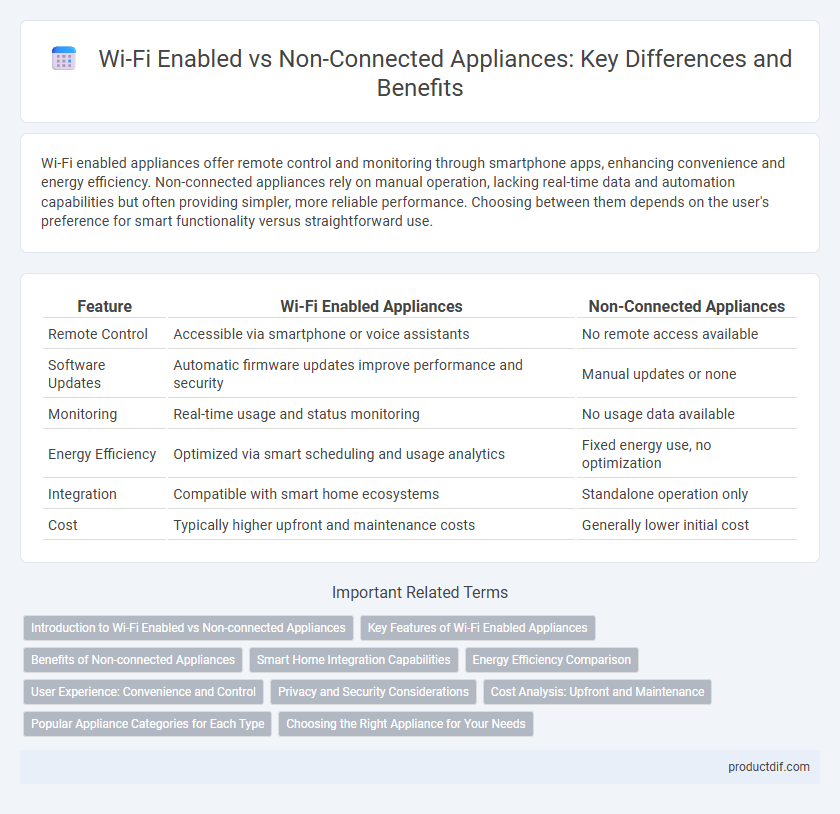Wi-Fi enabled appliances offer remote control and monitoring through smartphone apps, enhancing convenience and energy efficiency. Non-connected appliances rely on manual operation, lacking real-time data and automation capabilities but often providing simpler, more reliable performance. Choosing between them depends on the user's preference for smart functionality versus straightforward use.
Table of Comparison
| Feature | Wi-Fi Enabled Appliances | Non-Connected Appliances |
|---|---|---|
| Remote Control | Accessible via smartphone or voice assistants | No remote access available |
| Software Updates | Automatic firmware updates improve performance and security | Manual updates or none |
| Monitoring | Real-time usage and status monitoring | No usage data available |
| Energy Efficiency | Optimized via smart scheduling and usage analytics | Fixed energy use, no optimization |
| Integration | Compatible with smart home ecosystems | Standalone operation only |
| Cost | Typically higher upfront and maintenance costs | Generally lower initial cost |
Introduction to Wi-Fi Enabled vs Non-connected Appliances
Wi-Fi enabled appliances allow remote control and monitoring through smartphone apps, enhancing convenience and energy efficiency by providing real-time usage data. Non-connected appliances operate independently without internet access, offering reliability and simplicity but lacking smart features such as voice control or automatic updates. Choosing between these options depends on the user's preference for smart home integration versus straightforward functionality.
Key Features of Wi-Fi Enabled Appliances
Wi-Fi enabled appliances offer remote control and monitoring through smartphone apps, enabling users to adjust settings, receive alerts, and schedule operations from anywhere. They integrate with smart home ecosystems like Alexa and Google Assistant for voice commands and automation. These appliances also provide usage data and maintenance notifications, enhancing efficiency and convenience compared to non-connected models.
Benefits of Non-connected Appliances
Non-connected appliances offer enhanced privacy and security by eliminating risks associated with hacking or data breaches common in Wi-Fi-enabled devices. They provide reliable operation without dependency on internet connectivity, ensuring consistent performance even during network outages. Maintenance and usage remain straightforward, reducing complexity and potential technical issues for users.
Smart Home Integration Capabilities
Wi-Fi enabled appliances offer seamless smart home integration, allowing users to control devices remotely through smartphone apps or voice assistants like Alexa and Google Assistant. Non-connected appliances lack this capability, limiting automation and real-time monitoring in smart home ecosystems. The ability to sync with other smart devices enhances convenience, energy efficiency, and customization in daily appliance use.
Energy Efficiency Comparison
Wi-Fi-enabled appliances offer precise energy management through remote monitoring and real-time usage adjustments, reducing overall power consumption by up to 15% compared to non-connected models. Non-connected appliances rely on manual settings and often maintain constant energy use, lacking adaptive efficiency features. Smart connectivity enables integration with energy-saving schedules and utility demand response programs, further enhancing efficiency and lowering electricity costs.
User Experience: Convenience and Control
Wi-Fi enabled appliances offer unparalleled convenience by allowing users to remotely monitor and control settings via smartphone apps, enhancing ease of use and real-time adjustments. Non-connected appliances require manual operation onsite, limiting flexibility and immediate responsiveness in busy daily routines. The integration of smart technology in Wi-Fi enabled devices significantly improves user experience by providing personalized control and energy management features.
Privacy and Security Considerations
Wi-Fi enabled appliances transmit data that may be vulnerable to unauthorized access, making robust encryption protocols and regular firmware updates essential for protecting user privacy. Non-connected appliances inherently minimize data exposure by operating offline, reducing risks associated with hacking or data breaches. Consumers should weigh the convenience of remote control against potential security vulnerabilities when choosing between connected and non-connected appliances.
Cost Analysis: Upfront and Maintenance
Wi-Fi-enabled appliances typically have a higher upfront cost compared to non-connected models due to advanced hardware and integrated smart technology. Maintenance expenses might also increase with Wi-Fi-enabled devices, as they require ongoing software updates and potential cybersecurity protections. Non-connected appliances generally incur lower initial and maintenance costs, relying solely on standard mechanical repairs and replacements.
Popular Appliance Categories for Each Type
Wi-Fi enabled appliances dominate popular categories such as smart refrigerators, robotic vacuums, and connected ovens, offering remote control and automation features. Non-connected appliances remain prevalent in essential categories like traditional microwaves, basic washing machines, and simple toasters due to their affordability and ease of use. Consumer preference often hinges on balancing advanced technology benefits with budget and simplicity requirements in each appliance category.
Choosing the Right Appliance for Your Needs
Wi-Fi enabled appliances offer remote control and monitoring, enhancing convenience and energy efficiency, ideal for smart home integration. Non-connected appliances provide reliable performance without reliance on internet connectivity, making them suitable for users prioritizing simplicity and security. Choosing the right appliance depends on your lifestyle preferences, technological comfort, and the importance of features like automation and remote access.
Wi-Fi Enabled vs Non-connected Infographic

 productdif.com
productdif.com